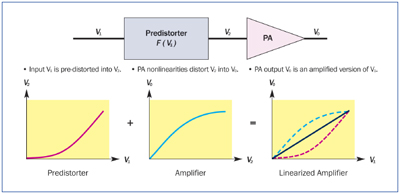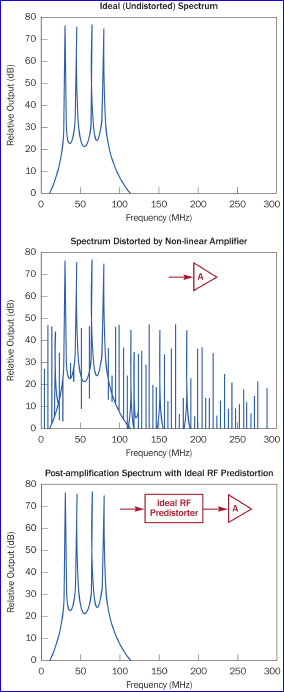Combining Antennas
Save real-estate using digital pre-distortion to linearize power amplifiers.
In multiple channel applications of the next-gen communication systems, it is often desirable to develop an antenna system to combine many of these antennas into fewer antennas by using modern wide-band antennas and power amplifiers for multiple transmitters. This can be extremely helpful because in many locations, the deck of a vessel for instance, real estate is so limited it is not possible to mount every antenna required for each possible frequency range and application. Through the use of wide-band antennas and power amplifiers (PA), the power, weight and the amount of real estate consumed by antennas and electronics can be significantly reduced. This would permit smaller vessels to have the same capability as larger vessels and increase their tactical advantage.
To maximize efficiency, modern wide-band power amplifiers must operate in a nonlinear region. However, this creates large variations in the instantaneous output power, a condition described as high peak-to-average ratio (PAR). As a result, signals are distorted. To compensate for this distortion, linearization techniques must be applied to minimize spectral re-growth or intermediation products created by the nonlinearity of wide-band amplifiers. A method called digital pre-distortion is used to distort the signal prior to the input of the power amplifier. The signal is distorted such that the composite output of the power amplifier appears to have linear amplification over the desired frequency range, without distortion. Figure 1 shows the digital pre-distortion method, which is used to linearize power amplifiers over very broad bandwidths. Figure 2 shows an example of the effects of power amplifier nonlinearities on a transmitted spectrum and the potential spectral benefits of applying digital pre-distortion.

Figure 1. Linearization of a PA using digital pre-distortion. Courtesy Northrop Grumman.

Figure 2. a) Ideal (undistorted) spectrum; b) spectrum distorted by nonlinear amplifier; and c) post-amplification spectrum with ideal RF pre-distortion.
The effectiveness of digital adaptive pre-distortion is that it enables high power amplifier linearization of spectrum to combine multiple transmitters across entire VHF and UHF ranges. Harmonic or intermediation products are reduced by more than 15 dBm. Additionally, cancellation improves receiver dynamic range.
In the proposed antenna combining, pre-distortion is performed by digital signal processing techniques using open architectures that enable reduced cost and increased flexibility of the system. System level control, switch control for communication equipment selection, oscillator control and antenna selection are supplied by a standard single board computer utilizing a Versa Module European (VME) bus-based chassis. Also, populated in this VME chassis is a software-defined radio board, a wideband transceiver board consisting of field-programmable gate arrays, analog-to-digital converter, and digital-to-analog converter (DAC).
The digital signal processing for the pre-distorter is performed by FPGAs using a down converted and sampled signal. The signal is mixed down to an intermediate frequency for sampling by an analog to digital converter for input to the FPGA for filtering. Then the filtered digital data are sent to a DAC, which is then mixed back to the carrier frequency for input to the power amplifier. Thus an undistorted signal is output to the antenna for improved signal integrity. If the bandwidth of the pre-distorter is large enough, then multiple communication systems within the same frequency range can be combined to utilize the same amplifier and antenna set.
Some precautions need to be taken to ensure the communication systems are not utilizing the same frequencies, and have ample channel separation. Since the pre-distorter is implemented in reconfigurable hardware FPGA, modifications to the pre-distorter are possible even after the system has been produced.
ACI Technologies Inc. (aciusa.org) is the National Center of Excellence in Electronics Manufacturing, specializing in manufacturing services, IPC standards and manufacturing training, failure analysis and other analytical services. This column appears monthly.




